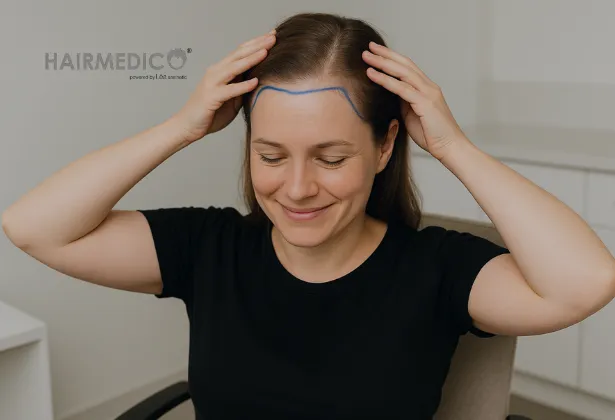
In women, hair loss often begins at the crown, but thinning around the hairline and temples can be even more emotionally distressing.
These areas define the facial frame, and even a small recession can make the face appear tired, aged, or harsher.
As Dr. Arslan Musbeh explains:
“In women, the hairline is not just hair — it defines their identity. When it recedes, it changes their facial expression, self-image, and confidence.”
Female pattern hair loss leads to gradual thinning rather than complete baldness.
The frontal and temple areas may lose volume as the follicles shrink over time.
Clinical example:
A 40-year-old patient presented with a 1.5 cm recession and temple thinning.
Dr. Musbeh used the Sapphire FUE method to implant 1,600 grafts, creating a soft and feminine contour.
After 12 months, the hairline looked fully natural and dense.
Hormonal fluctuations caused by pregnancy, menopause, thyroid disorders, or PCOS can disturb the natural growth cycle.
After menopause, declining estrogen levels make the hair thinner and more fragile, especially at the temples.
Hairmedico approach:
In post-menopausal women with reduced hair diameter, PRP combined with DHI can restore thickness and vitality by stimulating dormant follicles.
Continuous tension from tight ponytails, braids, or buns can lead to permanent follicle damage, especially near the temples.
Example:
A professional dancer who wore tight buns for years developed 3 cm bald patches at both temples.
Through DHI (Direct Hair Implantation) with 950 grafts, her natural temple contour was restored.
Within 10 months, the result appeared symmetrical, full, and natural.
Frequent bleaching, coloring, or heat styling weakens follicles, particularly around the front hairline.
Before any transplant or PRP treatment, patients are advised to stop chemical processes for at least three months.
This condition, common among post-menopausal women, causes permanent loss along the hairline due to inflammation.
Hair transplantation is only recommended once the disease becomes inactive.
Hairline and temple thinning in women usually progresses silently.
At first, hair simply becomes finer; later, the frontal line visibly recedes.
Typical signs include:
Gradual widening of the forehead
Triangular bald patches at the temples
Difficulty achieving volume when styling
A thinner, weaker texture at the front
Early diagnosis allows non-surgical treatments before follicles are irreversibly lost.
Every assessment begins with a detailed medical evaluation:
Trichoscopy (microscopic scalp analysis) – measures follicle health, density, and hair thickness.
Blood tests – check ferritin, vitamin D, thyroid, estrogen, and androgen levels.
Donor area evaluation – determines graft availability for potential transplantation.
Digital simulation – visualizes the new hairline design before treatment.
This analysis helps choose the most effective solution — medical therapy, PRP, or hair transplantation.
Topical Minoxidil 2–5% — prolongs the hair growth phase.
PRP (Platelet-Rich Plasma) — revitalizes follicles using growth factors from the patient’s blood.
Mesotherapy — injects biotin, zinc, amino acids, and vitamins directly into the scalp.
Hormonal therapy — anti-androgen medications like spironolactone (under medical supervision).
For stable, irreversible loss, Sapphire FUE or DHI (no-shave technique) offer long-term results.
Advantages:
No full shaving required
Natural, feminine hairline design
Fast healing (7–10 days)
Permanent and realistic outcome
Dr. Arslan Musbeh is internationally recognized for his expertise in female hairline and temple restoration.
Each design is individually planned according to facial proportions, age, and natural hair direction.
At Hairmedico, all procedures are:
Personally supervised by Dr. Musbeh
Performed with fine, micro-angled channels optimized for female density
Focused on maximum graft survival and aesthetic harmony
Case 1:
A 35-year-old woman with a 2 cm receded hairline received 1,200 DHI grafts.
By month 8, she achieved a soft and youthful contour.
Case 2:
A 32-year-old postpartum patient underwent PRP + Mesotherapy, achieving visible fullness by month 5 — no surgery required.
| Time After Treatment | Typical Progress |
|---|---|
| 1–3 months | Temporary shedding (“shock loss”) |
| 3–6 months | Early regrowth of new hair |
| 6–9 months | Noticeable increase in density |
| 12–15 months | Final natural and stable outcome |
Most women regain soft, directional, and natural growth that perfectly complements their facial features.
Hairline restoration for women is both a medical and emotional transformation.
Early intervention through medication or PRP can prevent progression; surgical solutions like DHI or Sapphire FUE offer a lasting, natural correction.
At Hairmedico, the goal is not only to replace hair but to recreate balance, femininity, and self-confidence — one hairline at a time.
Dr. Arslan Musbeh, internationally recognized Hair Transplant Surgeon, is the founder of Hairmedico.
With over 17 years of experience, he specializes in FUE, Sapphire FUE, and DHI techniques, combining medical expertise and artistic design to deliver natural, permanent results.